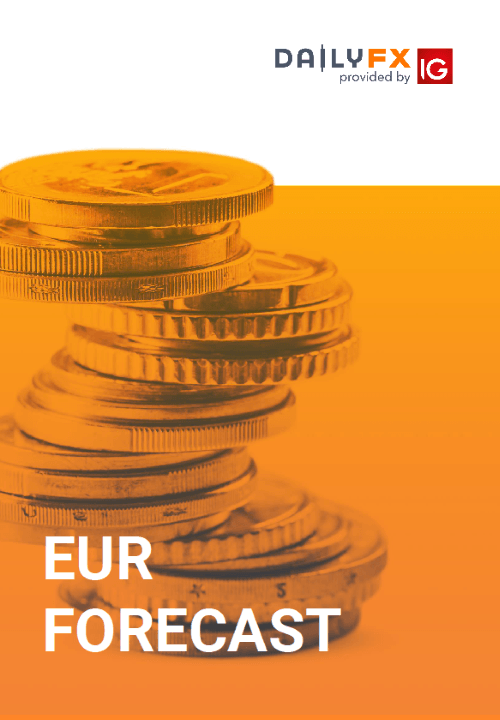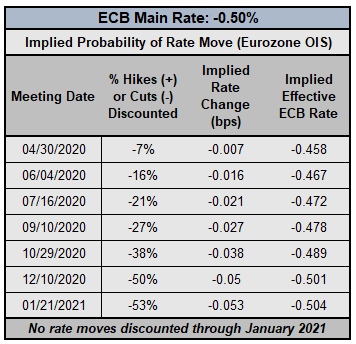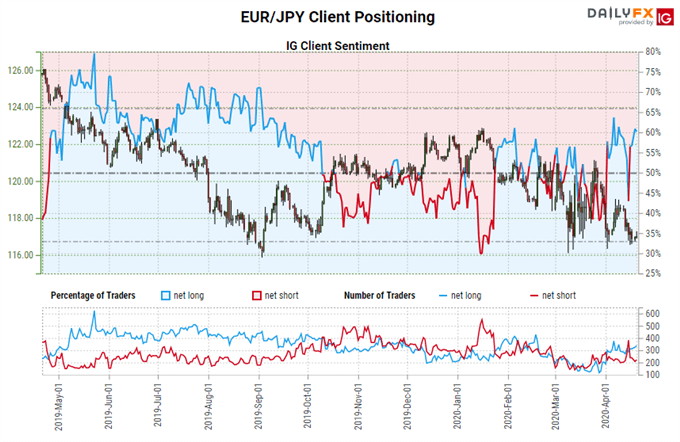Euro Forecast Overview:
- Although Euro losses have slowed over the past few weeks, the context of the recent consolidations offers little reassurance for bulls. More weakness may be around the corner yet.
- The forex economic calendar is fairly significant for the Euro over the coming days, with the April German and Eurozone ZEW surveys due on Tuesday and the European Commission’s economic forecasts due out on Friday.
- Per the IG Client Sentiment Index, the Euro has a downside trading bias.

Recommended by Christopher Vecchio, CFA
Get Your Free EUR Forecast
Euro Slowly Sinking Throughout April
The Euro has been seemingly quiet for the past few weeks, after having endured a burst of two-way volatility in March. Yet as all the attention has gone to global equity and commodity markets, the Euro has quietly been enduring a slow burn for the month of April, having lost ground versus every major currency: EUR/AUD is the worst performer, down by -5.57%; and EUR/CHF is the best performer, down by -0.80%.
Eurozone Economic Data Sours Rapidly
And so while many of the headlines are about how dire the economic situation in the United States has become, it would appear that market participants are staking a more bearish claim to the situation in the Eurozone. Indeed, the coronavirus pandemic is proving to fray at the institutional bonds that tie the European Union’s 27 members together, once again bringing into question the long-term stability of the Euro project on the whole.
The backdrop of rapidly deteriorating economic data is not helping the Euro in any sense. The Citi Economic Surprise Index for the Eurozone, a gauge of economic data momentum, currently sits at -61.4 today, a sharp decline relative to its high of the year set on January 24 at 50.8 and its high prior to the impact of the coronavirus pandemic, set on March 16 at 14.3. Now that March and April economic data are starting to come into focus, more bad news seems destined on the horizon.
ECB Signals Willingness to Do More
Part of the issue dogging the Euro right now is that policymakers have not been nearly as aggressive as they need to be in their fiscal and monetary responses. The European Central Bank’s self-imposed period of review has proved to be a mistake, which was envisioned as a way to reset relationships among the Governing Council after current ECB President Christine Lagarde’s predecessor, Mario Draghi strong armed a number of policy changes prior to his exit in October 2019.
European Central Bank Interest Rate Expectations (April 20, 2020) (Table 1)

If and when the ECB finally steps up to the plate to deliver, traders don’t believe that it will do so through the typical interest rates channel. According to overnight index swaps, the ECB is not expected to change rates through the end of 2020 (50% chance by December for a 10-bps rate cut), and the pricing for January 2021 still does not rise past our threshold of 55% (currently sitting at 53%).
But traders should expect something soon. Over the weekend, ECB Governing Council member Francois Villeroy de Galhau said that, with inflation falling below 2%, despite the fact that interest rates remain very low and liquidity remains ample, “if we had to do more to fulfil the price stability mandate entrusted to us by the (EU) treaties, we will do more.“
EUR/USD Rate versus COT Net Non-Commercial Positioning: Daily Timeframe (April 2019 to April 2020) (Chart 1)

That the ECB may be considering new programs that are not currently priced into the market suggests that there may be more weakness ahead of the Euro. Perhaps the most potent aspect of a potential stretch of Euro weakness anew is the fact that positioning has built up so dramatically in recent weeks, despite the fact that the Euro has been the worst performing currency in April.
According to the CFTC’s COT report for the week ended April 14, speculators increased their net-long Euro positions from 79.6K to 86.6K contracts. Even as futures positioning has flipped from net-short to net-long over the past two months, EUR/USD rates have not been able to gain any topside traction. Oversaturated long positioning leaves the Euro at risk for a covering move that ultimately pushes the Euro lower.
EUR/USD RATE TECHNICAL ANALYSIS: DAILY CHART (April 2019 to April 2020) (CHART 2)

In the last update on the EUR/USD rate forecast, it was noted that the“symmetrical that has formed may retain a bearish bias, insofar as it was created after a sharp decline from the March highs.” For now, this statement holds.
Daily MACD is no longer rising while in bearish territory, while Slow Stochastics has fallenl back above its median line. There is currently little agreement among the daily 5-, 8-, 13-, and 21-EMA envelope, but the envelope is starting to bend to the downside.
Traders should remain neutral as symmetrical triangles dictate; but the downside breakout for EUR/USD rates is looking like it may gather pace soon.
IG Client Sentiment Index: EUR/USD Rate Forecast (April 20, 2020) (Chart 3)

EUR/USD: Retail trader data shows 47.57% of traders are net-long with the ratio of traders short to long at 1.10 to 1. The number of traders net-long is 10.11% higher than yesterday and 23.42% lower from last week, while the number of traders net-short is 10.02% higher than yesterday and 30.49% higher from last week.
We typically take a contrarian view to crowd sentiment, and the fact traders are net-short suggests EUR/USD prices may continue to rise.
Positioning is less net-short than yesterday but more net-short from last week. The combination of current sentiment and recent changes gives us a further mixed EUR/USD trading bias.
EUR/JPY RATE TECHNICAL ANALYSIS: DAILY CHART (April 2019 to April 2020) (CHART 4)

After failing at the rising trendline going back to the 2012, 2016, and 2019 swing lows at the start of 2020. EUR/JPY rates have traded back towards their 2019 lows, consolidating in a symmetrical triangle along the way. The longer-term context of losses dating back to the 2018 suggests that more downside may be imminent in EUR/JPY rates.
At present time, bearish momentum has started to gather pace again. EUR/JPY rates are below their daily 5, 8-, 13-, and 21-EMA envelope, which is in bearish sequential order. Daily MACD is trending lower in bearish territory, while Slow Stochastics have fallen into oversold condition. Bearish momentum may seem soft, but the conditions are in place for a more aggressive breakdown.
IG Client Sentiment Index: EUR/JPY Rate Forecast (April 20, 2020) (Chart 5)

EUR/JPY: Retail trader data shows 63.55% of traders are net-long with the ratio of traders long to short at 1.74 to 1. The number of traders net-long is 18.95% higher than yesterday and 33.33% higher from last week, while the number of traders net-short is 4.46% higher than yesterday and 18.18% lower from last week.
We typically take a contrarian view to crowd sentiment, and the fact traders are net-long suggests EUR/JPY prices may continue to fall.
Traders are further net-long than yesterday and last week, and the combination of current sentiment and recent changes gives us a stronger EUR/JPY-bearish contrarian trading bias.


Recommended by Christopher Vecchio, CFA
Traits of Successful Traders
— Written by Christopher Vecchio, CFA, Senior Currency Strategist


Be the first to comment